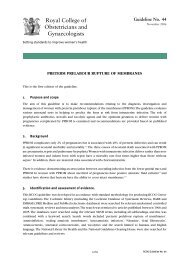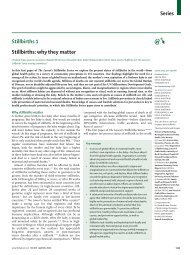Pelvic organ prolapse
Pelvic organ prolapse
Pelvic organ prolapse
Create successful ePaper yourself
Turn your PDF publications into a flip-book with our unique Google optimized e-Paper software.
Do I have to have treatment?<br />
No. If you only have a mild <strong>prolapse</strong> or have no symptoms from your <strong>prolapse</strong>, you may<br />
choose or be advised to take a ‘wait and see’ approach.<br />
However, the following may ease your symptoms and stop your <strong>prolapse</strong> from becoming worse:<br />
• Lifestyle changes:<br />
◦{<br />
losing weight if you are overweight<br />
◦{<br />
managing a chronic cough if you have one; stopping smoking will help<br />
◦{<br />
avoiding constipation; talk to your doctor about ways of helping and treating<br />
constipation<br />
◦{<br />
avoiding heavy lifting; you may wish to talk to your employer if your job<br />
involves heavy lifting<br />
◦{<br />
avoiding physical activity such as trampolining or high-impact exercise.<br />
• <strong>Pelvic</strong> floor exercises may help to strengthen your pelvic floor muscles. You may be<br />
referred for a course of treatment to a physiotherapist who specialises in <strong>prolapse</strong>.<br />
• Vaginal hormone treatment (estrogen) – if you have a mild <strong>prolapse</strong> and you have<br />
gone through the menopause; your doctor may recommend vaginal tablets or cream.<br />
What are my options for treatment?<br />
Your options for treatment will depend on the type of <strong>prolapse</strong> you have, how severe it is and<br />
your individual circumstances. Treatment options include the following.<br />
Pessary<br />
• A pessary is a good way of supporting a <strong>prolapse</strong>. You may choose this option if you<br />
do not wish to have surgery, are thinking about having children in the future or have<br />
a medical condition that makes surgery more risky. Pessaries are more likely to help<br />
a uterine <strong>prolapse</strong> or an anterior wall <strong>prolapse</strong>, and are less likely to help a posterior<br />
wall <strong>prolapse</strong>. The pessary is a plastic or silicone device that fits into the vagina to<br />
help support the pelvic <strong>organ</strong>s and hold up the uterus. There are various types and<br />
sizes; your doctor will advise which one is best for your situation. The most commonly<br />
used type is a ring pessary.<br />
• Fitting the correct size of pessary is important and may take more than one attempt.<br />
• Pessaries should be changed or removed, cleaned and reinserted regularly. This<br />
can be done by your doctor, nurse or sometimes by yourself. Estrogen cream is<br />
sometimes used when changing the pessary, particularly if you have any soreness.<br />
• Pessaries do not usually cause any problems but may on occasion cause<br />
inflammation. If you have any unexpected bleeding, you should see your doctor.<br />
• It is possible to have sex with some types of pessary although you and your partner<br />
may occasionally be aware of it.<br />
5










